
Lake Valley
Introduction
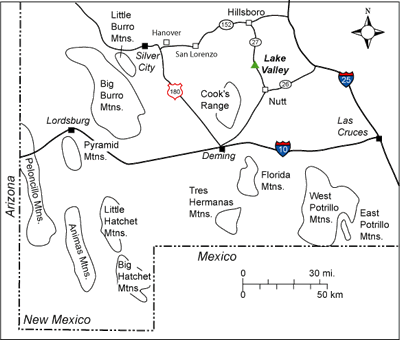
The ghost town of Lake Valley is located about 17 miles south of Hillsboro and 16 miles north of Nutt on New Mexico Highway 27 (Figure 1) in southwestern New Mexico. Lake Valley is in the southeastern Black Range, a northerly-trending mountain range west of the Rio Grande that is made up primarily of Eocene to Oligocene volcanic rocks derived from several eruptive centers in the Mogollon-Datil volcanic field.
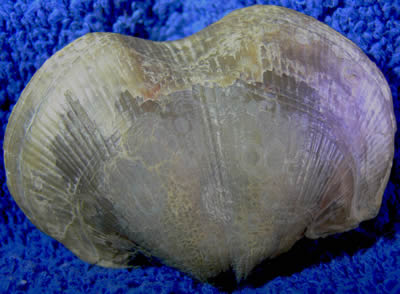
Apache Hill, located about 1.5 miles north of the ghost town of Lake Valley on the east side of New Mexico Highway 27, is one of the best fossil collecting sites in southern New Mexico. The fossils are in the Mississippian Lake Valley Limestone. Good outcrops are located just below the top of the hill. Intact fossils (Figure 2), including brachipods, bryozoans, crinoid plates and calyxes, and horn corals, weather out of the shaly limestone in this particular area. Other fossils that can be found include gastropods, pelecypods, cephalopods, and trilobites (Mack, 1997).
Lake Valley was a silver-manganese mining district during the late 19th century. Silver was discovered in 1876, and the area was extensively mined until the silver crash in 1893 (Donegan et al., 1965; McLemore and Nutt, 2002). The Lake Valley district includes the famed Bridal Chamber, which was found in 1881. The Bridal Chamber was among the richest silver deposits ever mined (Eveleth, 1986). The spectacular Bridal Chamber ore body composed of silver chlorides and silver bromides was nearly two hundred feet long and 25 feet thick (Clark, 1895; MacDonald, 1909: McLemore and Nutt, 2002). Chlorargyrite (cerargyrite; AgCl), the main high-grade ore taken from the Bridal Chamber, was mined out by the late 1880s. Manganese minerals, mainly manganite and pyrolusite, were mined in the Lake Valley district during and after World War II (Creasey and Granger, 1953). No significant mining activity has occurred in the area since 1959 (McLemore and Nutt, 2002).
Regional Setting
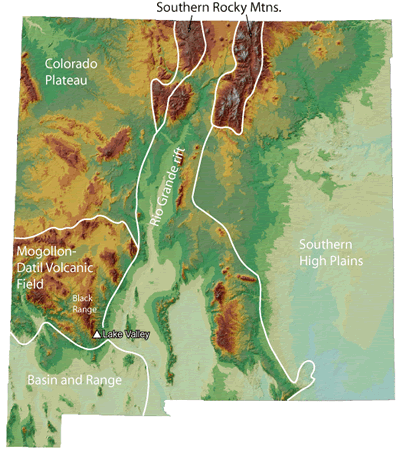
Lake Valley lies in the Mogollon-Datil volcanic field along the western margin of the Rio Grande rift (Figure 3). Remarkable geologic features like the Bridal Chamber form in places where a unique set of seemingly disconnected geologic events affect a geographically small area. In the Lake Valley region, deposition of carbonates on the floor of an ocean 350 million years ago provided a suitable host rock for mineralization. These carbonates belong to the Mississippian Lake Valley Limestone. Much later, about 50 to 60 million years ago, the Lake Valley region was just south of the northern margin of the northwest-striking Rio Grande uplift (Seager et al., 1986; O'Neill et al., 2002; Figure 4), which developed as a result of compressional Laramide deformation. The Mississippian Lake Valley Limestone was deformed during this event, creating numerous east-west trending normal faults on the crest of the Laramide highland that later served as conduits for mineralizing fluids (Figure 5).
Volcanism in the Mogollon-Datil volcanic field started about 40 million years ago. Collapse of the Emery caldera just northwest of the ghost town occurred 34.9 million years ago and younger intrusions associated with this event leaked up along ring fractures 34.5 million years ago. The ring fracture rhyolite intrusion on Town Mountain just west of Lake Valley likely provided the fluids involved in the silver mineralization, but the mineral deposits could have formed before 36 million years ago (see mineralization section). Rio Grande rift extensional faulting has since brought these deposits to shallow depths, where interaction with groundwater concentrated the silver minerals to create the Bridal Chamber, an exceptional deposit seen only by late 19th century miners.
Geologic History
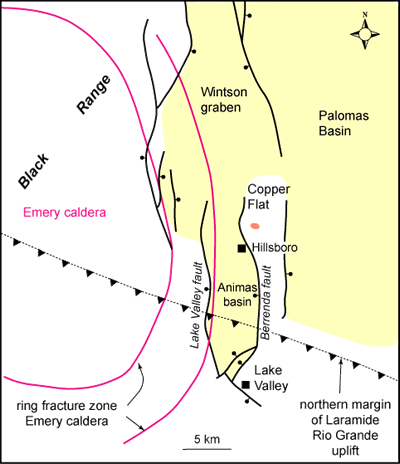
Lake Valley is in a southeast-dipping fault block made up of Paleozoic dolomite, limestone, and shale that is surrounded by Tertiary volcanic rocks. Paleozoic rocks exposed here include Ordovician El Paso Group and Montoya Group dolomite and limestone, Silurian Fusselman Dolomite, Devonian Percha Shale, and Mississippian Caballero Formation and Lake Valley Limestone. The dolomite and limestone in the Ordovician and Silurian units were deposited in a warm, shallow ocean along a tectonically stable, southward-sloping continental shelf between 480 and 425 million years ago. Erosional breaks in the rock record occur between the El Paso and the Montoya and between the Montoya and the Fusselman (Jicha, 1954). In general few fossils are preserved in these units. The Ordovician carbonates contain trilobites, gastropods, brachiopods, crinoids, bryozoans, and corals; the Fusselman Dolomite has the occasional brachiopod or coral (Jicha, 1954). The Middle Silurian Fusselman Dolomite and the Upper Devonian Percha Formation are separated by a significant unconformity. The Percha Formation, characterized by black shale intercalated with thin discontinuous beds and nodules of gray limestone, was deposited between 385 and 360 million years ago in seawater that contained little oxygen. Fossils are very rare in the Percha Formation. Fossiliferous thin-bedded limestone, shale, and chert pebble conglomerate of the Mississippian Caballero Formation overlie the Percha Shale, indicating that the amount of oxygen in the shallow marine waters had returned to life-supporting levels by Mississippian time. The Lake Valley Limestone unconformably overlies the Caballero Formation; both Mississippian carbonate units were deposited along the margin of a shallow ocean between 360 and 340 million years ago.
Late Paleozoic and Late Mesozoic strata likely were deposited in this area, but these sedimentary rocks were eroded from the crest of the northwest-trending Rio Grande uplift (Figure 4) during Laramide compressional deformation 50 to 60 million years ago. Conglomerate in the Paleocene to Eocene Love Ranch Formation, which is preserved in patches in the Lake Valley area (Figure 5), contains chert and fossils eroded from the Lake Valley Limestone, indicating that this unit is locally derived (McLemore and Nutt, 2002). The northwest-striking segment of the Lake Valley fault on the southwestern side of the mining district and the west-northwest-striking faults within the district likely developed during Laramide deformation (Figures 4 and 5).
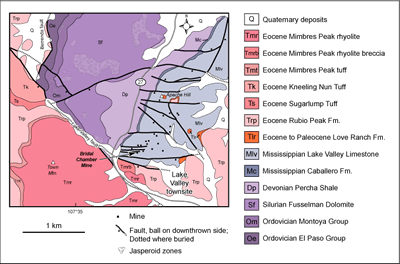
The Eocene Rubio Peak Formation is a thick sequence of andesitic to dacitic lava flows and interbedded volcaniclastic sediments that laps onto the older rocks in the region. This volcanic unit was derived from sources to the west of Lake Valley in the Mogollon-Datil volcanic field. The basal conglomerate in the Rubio Peak Formation includes angular to subrounded pebbles and cobbles of red Permian Abo Formation sandstone and siltstone, rounded pebbles of Pennsylvanian limestone, and andesite (O’Neill at al., 2002). The exact age of the Rubio Peak Formation has not yet been determined, but we do know that the unit was deposited before 35.17±0.12 million years ago, based on the age of the overlying Sugarlump Tuff (McIntosh et al., 1991; O’Neill et al., 2002). The volcanic source of the Sugarlump Tuff is unknown, but possible vent breccia is preserved approximately 3 miles northwest of Lake Valley (O’Neill et al., 2002). The eruption that formed the Sugarlump Tuff was quite small compared to other rhyolitic eruptive events elsewhere in the volcanic field. Subsequent erosion carved topography onto and locally removed the Sugarlump Tuff. The voluminous Kneeling Nun Tuff, which erupted from the Emery caldera 34.89±0.05 million years ago, later overran and filled in the eroded landscape. Caldera collapse created concentric fractures that were later filled by intrusions of the 34.5-million-year-old Mimbres Peak Formation rhyolite and associated tuffs and breccias, including the Town Mountain dome west of Lake Valley. The ring fractures were later reactivated during Rio Grande rift extension to form the Berrenda fault zone and the north-striking part of the Lake Valley fault system (O’Neill et al., 2002; Figure 4). Extension began during Oligocene time, but peaked during Miocene-Pliocene time. Eocene volcanic rocks were faulted against the Paleozoic rocks on the west and southwest side of the mining district and the fault block was tilted to the southeast as a result of the most recent phase of faulting in the region.
Mineralization
The Lake Valley Limestone is the primary host rock of the silver and manganese mineralization. Miners working the deposits during the late 19th century assigned informal, yet wonderfully descriptive, names to the four members of the Lake Valley Limestone in the mining district. The informal units were, from oldest to youngest, nodular limestone, blue limestone, crinoidal limestone, and upper limestone (Donegan et al., 1965). Laudon and Bowsher (1949) later formally applied the names Andrecito Member, Alamogordo Member, Nunn Member, and Tierra Blanca Member, respectively, to the informal units. The mined deposits were mainly in the Alamogordo Member and the lower part of the Nunn Member.
The fluids associated with mineralization are presumably related to Eocene volcanism, but the exact timing of mineral deposition and exact source of the fluid within the mining district are poorly understood. Outside the mining district, large areas of Fusselman Dololmite located a short distance below the contact with the relatively impermeable Percha Shale have been replaced by jasperoid, a silica rich rock (Figure 5). Jasperoid also has replaced parts of the Ordovician Montoya Formation (Figure 5). The jasperoids outside the mining district are barren; in other words, they do not contain mineral deposits. The relationship of the barren jasperoids in the Ordovician and Silurian carbonates to mineralized silica-rich layers in the Lake Valley Limestone within the mining district is not clear, but one thing is certain: the Eocene Rubio Peak Formation rests on the barren jasperoids in the Fusselman Dolomite. Thus, the barren jasperoids formed prior to about 36 million years ago (O’Neill et al., 2002).
Although the timing of mineralization and the source of the fluids are not well known, we do know that mineralized fluids moved along the west-northwest faults and fractures in the Lake Valley Limestone. Some minerals precipitated out of solution along the steeply dipping faults and fractures. The most productive deposits at Lake Valley are associated with fractured rocks near fault splays and folds along the Lake Valley fault. Interestingly, the Lake Valley fault and the Berrenda fault zones are only locally and weakly mineralized (Harley, 1934; Creasy and Granger, 1953; Young and Lovering, 1966; McLemore and Nutt, 2002). The mineralized fluids then moved away from the faults along certain beds in the Alamogordo Member, forming roughly tabular replacement ore bodies that typically parallel the bedding (Young and Lovering, 1966). Some replacement mineralization occurred in the crinoidal limestone of the overlying Nunn Member. Initially, the mineralizing fluids were quite rich in silica, forming a silicified zone or chert layer (Harley, 1934). Soon after, the fluids became more enriched in metals (silver, manganese) and calcium carbonate and contained less silica; these fluids filled fractures in the initial silica layer. Primary silver minerals included stephanite, proustite, pyrargyrite, and silver-bearing galena (Harley, 1934; McLemore and Nutt, 2002). The ore bodies were later oxidized and concentrated by interaction with groundwater though a process called supergene enrichment as rift faults uplifted the Lake Valley fault block and erosion brought the deposits toward the surface. Minerals that formed oxidation and concentration phase are cerargyrite, embolite, native silver, cerussite, banadinite, wulfenite, endlichite, descloizite, and iodyrite (McLemore and Nutt, 2002).
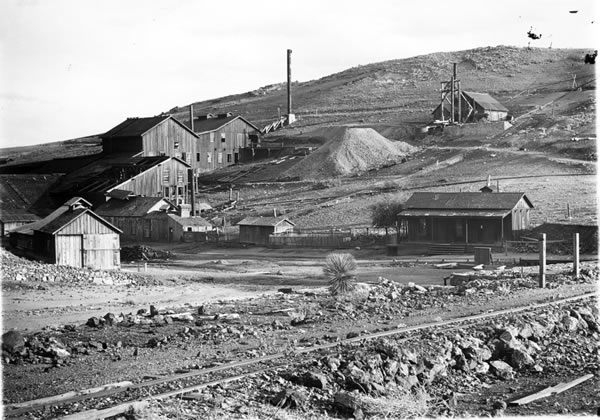
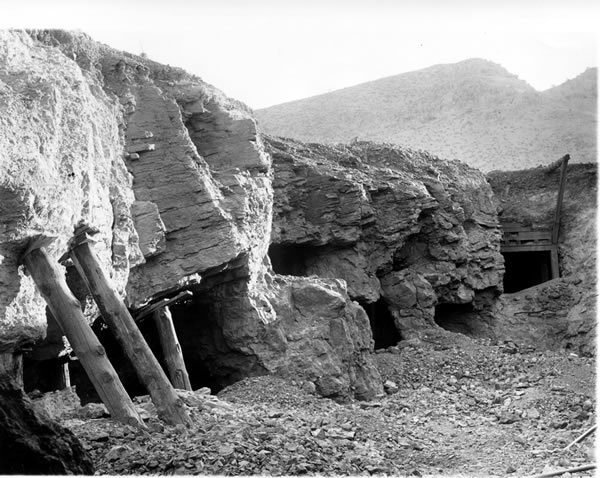
References
- Clark, E., Jr., 1895, The silver mines of Lake Valley, New Mexico: American Institute of Mining and Metallurgy Engineering Transactions, v. 24, p. 138–167.
- Creasey, S.C. and Granger A.E., 1953, Geologic map of the Lake Valley manganese district: U.S. Geological Survey Mineral Investigation Field Studies Map MF-9 scale 1:24,000.
- Donegan, B., Donegan, B., and Kottlowski, F., 1965, Road log from Nutt to Hillsboro: New Mexico Geological Society Guidebook, 16, p. 27-30.
- Eveleth, R.W., 1986, Lake Valley’s famed Bridal Chamber—“a beautifully large and solid looking streak”: New Mexico Geological Society Guidebook 37, p. 293–296.
- Harley, G.T., 1934, The geology and mineral deposits of Sierra County, New Mexico: New Mexico Bureau of Mining and Mineral Resources Bulletin 10. 220 p.
- Jicha, H.L.,Jr., 1954, Geology and mineral deposits of Lake Valley quadrangle, Grant, Luna, and Sierra Counties, New Mexico: New Mexico Bureau of Mining and Mineral Resources Bulletin 37, 93 p.
- Laudon, L.R., and Bowsher, A.L., 1949, Mississippian formations of southwestern New Mexico: Geological Society of America Bulletin, v. 60, p. 1–87.
- MacDonald, N., 1909, Discussion of the paper of Charles R. Keyes, p. 139: American Institute of Mining Engineers Transactions, v. 39, p. 850–856.
- McIntosh, W.C., Kedzei, L.L., and Sutter, J.F., 1991, Paleomagnetism and40Ar/39Ar ages of ignimbrites, Mogollon-Datil volcanic field, southwestern New Mexico: New Mexico Bureau of Mines and Mineral Resources Bulletin 135, 79 p.
- McLemore, V.T., and Nutt, C.J., 2002, Mineral deposits of the Lake Valley mining district, in O’Neill, J.M., ed., Geologic investigations of the Lake Valley area, Sierra County, New Mexico: U.S. Geological Survey Professional Paper 1644, 78 pp.
- Mack, G.H., 1997, The geology of southern New Mexico: A beginner's guide: University of New Mexico Press, Albuquerque, New Mexico: 176 pp.
- O’Neill, J.M., Lindsey, D.A., Hedlund, D.C., Nutt, C.J., and Ratte, J.C., 2002, Geology of the Lake Valley area, in O’Neill, J.M., ed., Geologic investigations of the Lake Valley area, Sierra County, New Mexico: U.S. geological Survey Professional Paper 1644, 78 pp.
- Seager, W.R., Mack, G.H., Raimonde, M.S., and Ryan, R.G., 1986, Laramide basement-cored uplift and basins in south-central New Mexico, in Clemmons, R.E., King, W.E., and Mack, G.H., 1986, eds., Truth or Consequences region: New Mexico Geological Society Guidebook 37, p. 123–130.
- Young E.J., and Lovering, T.G., 1966, Jasperoids of the Lake Valley mining district, New Mexico: U.S. Geological Survey Bulletin 1222-D, D1-D27.



